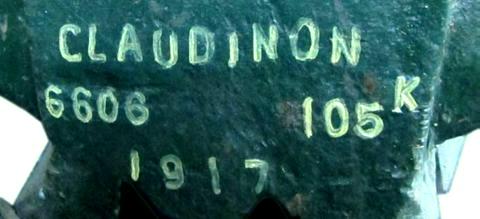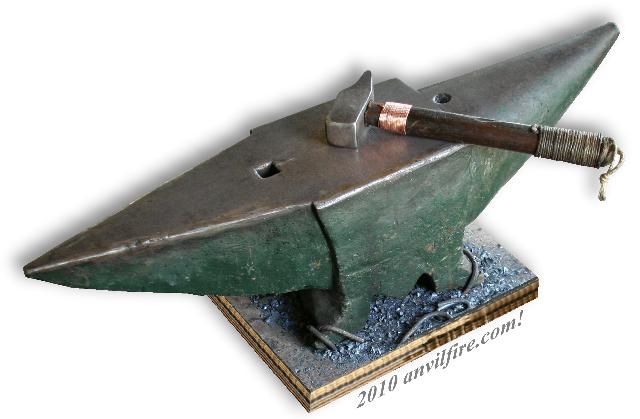From the collection of Marco Dell'Acqua, Italy.
The classic Italian anvil shape is similar to French and German types that developed during the same period.
All were slightly different styles but the same in that they all had similar feet and most had round and square horns.
The Italian's kept there shape until modern times.
These are popular in France, Italy and the Mediterranean in general.

The original markings have been impressed in the side of the anvil with punches.
The impression is not very deep, and difficult to get on camera, so I used some yellow marker to highlight them.
The writing reads:
CLAUDINON
6606 105K
1917
1st row,
CLAUDINON
Claudinon is a famous French forge operated from 1854 until 1963 in the city of city of Chambon-Feugerolles, France.
For more information see
Forez-info.com
The original rationalization is not unusual in trying to determine markings on old anvils:
Claudino being the diminutive of Claudio - Claude - and N being the first letter of the family name.
Usually in small communities no more was needed to unequivocally identify a person.
2nd row,
6606 105K
105K is the weight of the anvil (231.5 pounds), but I've no idea whatsoever what "6606" may mean
-
It is probably a serial number - guru.
3rd row,
1917
This is probably the year of the making
The "M" An interesting story told in Italy is that the space between the legs of the anvil makes an "M" which stands for Mossilini, the WWII Dictator.
It is unlikely that a French forge would include such a detail, especially since they mostly shut down, refusing to work for the Germans during WWII.
The detail also predates WWII. But such are modern myths.



_tn.jpg)
 Return to Misc and Donated Anvils Index
Return to Misc and Donated Anvils Index Anvil Collections Gallery Index
Anvil Collections Gallery Index
The classic Italian anvil shape is similar to French and German types that developed during the same period. All were slightly different styles but the same in that they all had similar feet and most had round and square horns. The Italian's kept there shape until modern times. These are popular in France, Italy and the Mediterranean in general.
The original markings have been impressed in the side of the anvil with punches. The impression is not very deep, and difficult to get on camera, so I used some yellow marker to highlight them. The writing reads:
6606 105K
1917
1st row, CLAUDINON
Claudinon is a famous French forge operated from 1854 until 1963 in the city of city of Chambon-Feugerolles, France. For more information see Forez-info.com
The original rationalization is not unusual in trying to determine markings on old anvils: 2nd row, 6606 105K
105K is the weight of the anvil (231.5 pounds), but I've no idea whatsoever what "6606" may mean - It is probably a serial number - guru.
3rd row, 1917
This is probably the year of the making
The "M" An interesting story told in Italy is that the space between the legs of the anvil makes an "M" which stands for Mossilini, the WWII Dictator. It is unlikely that a French forge would include such a detail, especially since they mostly shut down, refusing to work for the Germans during WWII. The detail also predates WWII. But such are modern myths.